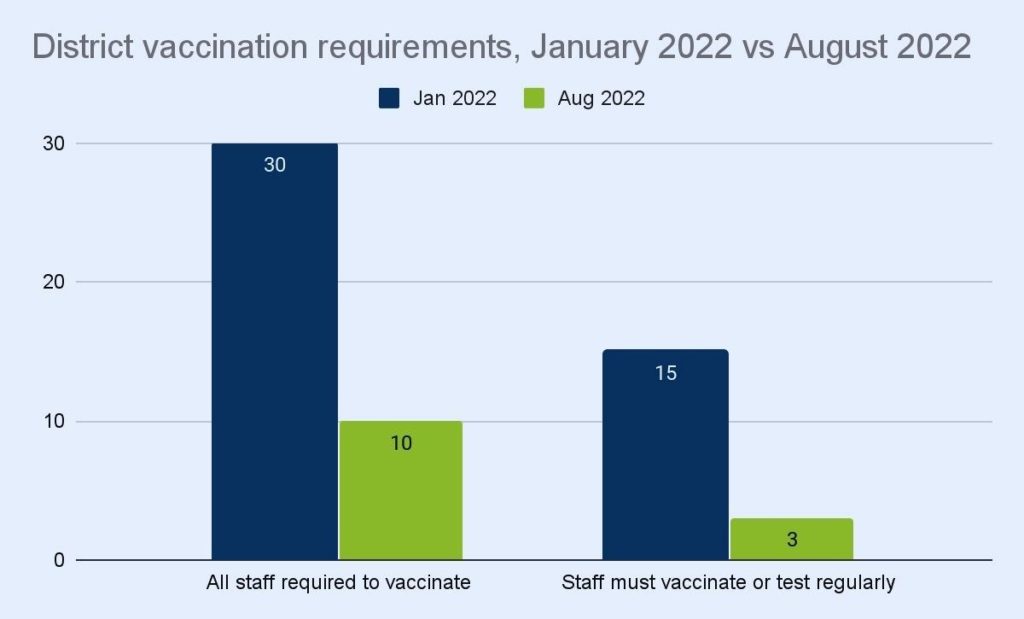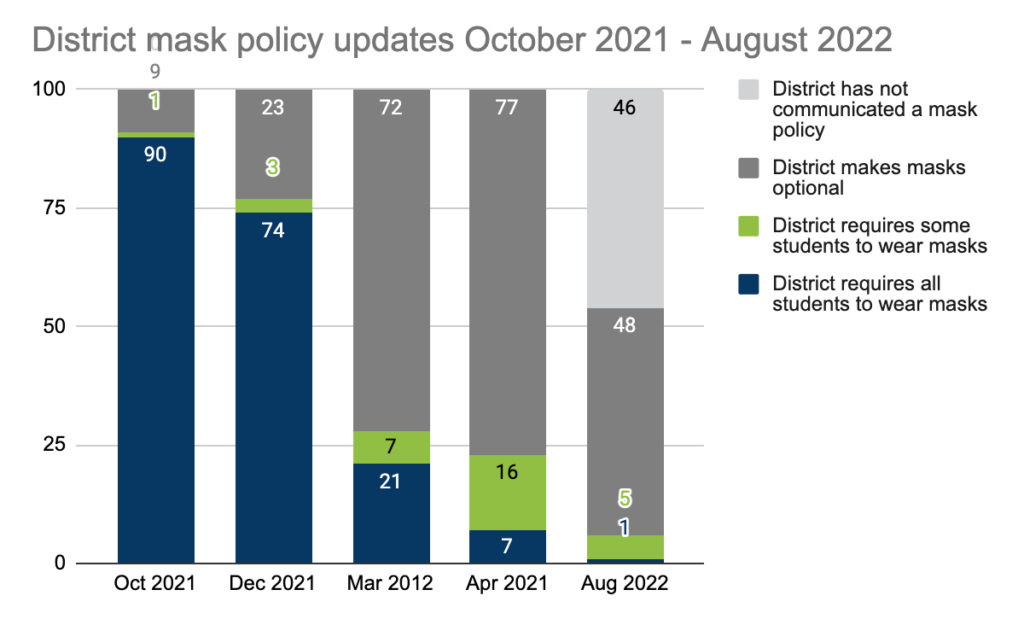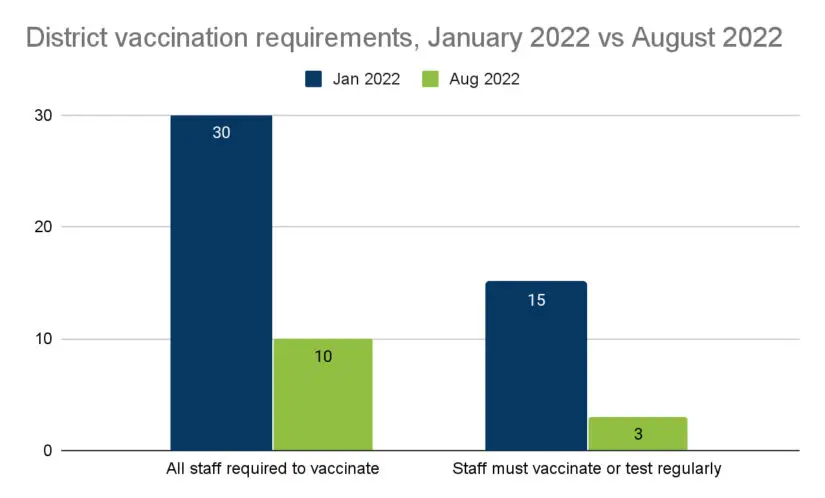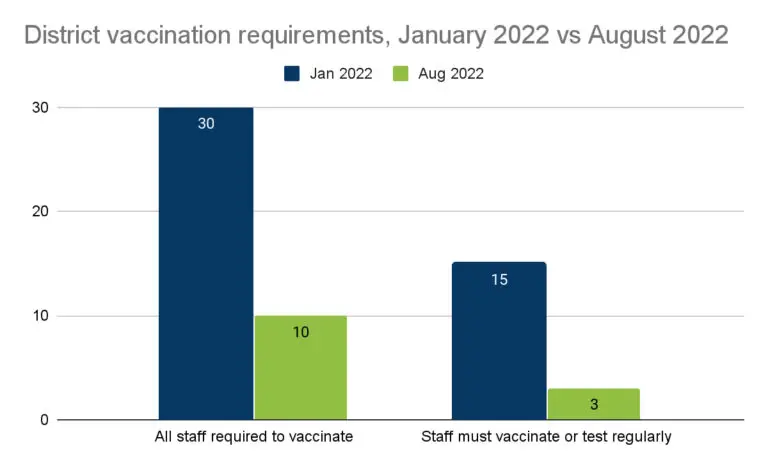This piece was originally published by The 74.
Dusseault: As 100 large districts gear up for a “normal” year, it’s not clear what will happen should another deadly COVID variant arise

For the past two years, start-of-school rituals and routines have been waylaid by virus surges, public health concerns, quarantines and overall uncertainty.
Will things be different this fall? So far, it looks to be the case.
Schools have been opening up across the country with relatively low fanfare in the first three weeks of August. Our regular review of 100 large and urban districts finds that all those that have started classes are in-person. None have reported closures due to COVID outbreaks. It appears that perhaps students are settling into something like the old sense of normal.
However, this is not a normal year. It follows a school year of multiple unanticipated virus surges, ongoing changes to health and safety policies, and dramatic reports of chronic absenteeism and staffing shortages.
While students and families are eagerly anticipating a simpler start to this year, it’s not clear that they are receiving adequate information about what to expect should another deadly variant arise.
Our review finds that just 55 have shared updated handbooks or websites that outline health and safety policies for the 2022-23 school year. Of those that have published information, it’s clear that districts are jettisoning many of the protective measures that they endorsed just months ago.
As of the third week of August, just one district in our review has a mask requirement in place. In Louisville, Kentucky, Jefferson County Schools has kept a mask requirement in place, dependent on the community infection rates. Masking is required for students and staff until the county is no longer in the red (high) level. The district updates its masking status at the end of each week on its website.

In Pennsylvania, Pittsburgh Public Schools has adopted a similar approach, linking its mask policy to community COVID levels. At the time we recorded our data, the district’s community infection level was “medium,” which allowed individuals to remove masks while participating in performances so long as they take weekly COVID tests . The infection rate has since risen to “high,” meaning that, like Jefferson, Pittsburgh now requires everyone to wear a mask in schools.
All other districts in our review have removed ongoing mask requirements. A small number — four — do mandate them for specific circumstances.
In Nevada’s Clark County School District and the Hawaii Department of Education, staff or students returning to school after a confirmed positive COVID diagnosis must wear a mask. Individuals in Clark County who have been exposed to the virus are required to mask up as well. In Virginia, Richmond Public Schools requires masks but allows parents to opt out on behalf of their children, and South Dakota’s Sioux Falls School District will require students showing symptoms of the virus to move to an isolated area of the school building until they can be picked up and taken home. While they wait, anyone who comes in contact with them is expected to wear a mask.
Fewer districts are also requiring vaccinations this school year, with 10 maintaining strict policies for their staff — just a third of the number that mandated staff vaccinations just six months ago.

All the districts requiring vaccinations in 2022-23 had a mandate in place the previous school year. Most, like Boston Public Schools and the New York City Department of Education, are continuing their policies from last year. Others, like Maryland’s Montgomery County Public Schools, have shifted their rules over time.
Montgomery County alternated between requiring vaccines for all staff and allowing regular testing in lieu of vaccination last fall, and landed on a policy that allowed employees to opt out and undergo weekly testing. This fall, it is opening the school year with tighter language that states: “MCPS currently requires staff to submit proof of COVID-19 vaccination or documentation of a medical exemption.” Employees who request an exemption must undergo regular testing.
Atlanta Public Schools does not require employee vaccinations, but all staff must undergo weekly testing. It is the only district in our review that has adopted this strategy.
Just two districts in our review require COVID vaccinations for students. D.C. Public Schools mandates them for students 12 and older, and New York City requires students to be vaccinated if they participate in high-risk extracurricular activities or sports. Several California districts scaled back student vaccine mandates planned for July 2022 after the state granted an extension until July 2023.
No district has a policy in place requiring testing for all students.
Signs in these first weeks of the academic year look positive that schools are moving toward the most “normal” start to a year since the virus took the country by surprise in early 2020.
As new data paint an increasingly grim picture about the toll the pandemic, school closures and continuing operational uncertainty in schools took on learning, attendance and staff morale, this is welcome news. CRPE will release a comprehensive “State of the Student” report in September, compiling more data on student learning and well-being since the pandemic’s start and highlighting potential solutions for the road ahead.
While masks, testing and vaccines remain important strategies for containing the virus’ spread, district leaders appear to be giving them less priority than last year. This suggests they recognize that the public has grown more tolerant of COVID and less willing to accept measures designed to stop its spread. In other words, district leaders appear to be calculating that the political and logistical costs of keeping last year’s safety measures in place do not outweigh the value of a normal year with fewer disruptions.
That does not mean districts can afford simply to return to pre-pandemic ways of doing business. Families, staff, and students need continued clear communication about what to expect as schools return to traditional schedules and expectations, and they deserve to know what to expect if rising viral caseloads or other unanticipated events threaten the stability of yet another school year.
This year presents an opportunity for public school systems to regain families’ trust. Some districts are taking this to heart, sharing clear and careful plans for the future. Sadly, others have already fallen silent.





